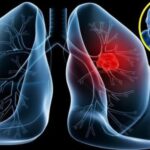Lung cancer is one of the most common cancers with high mortality rates in many countries, including Vietnam. Early detection of symptoms can improve treatment outcomes and increase survival rates for patients. Notably, signs appearing in the feet can be an early warning of late-stage lung cancer, but many people tend to overlook them.
Weiwei, a 48-year-old software engineer in Beijing, serves as an illustrative example. After a prolonged period of work-related stress and frequent late nights, he developed persistent coughing and unusual symptoms in his feet, including swelling, pain, and a sense of heaviness. Initially, Weiwei paid little attention to these signs, but as the symptoms worsened, he sought medical attention and was diagnosed with late-stage lung cancer. Weiwei’s case is not uncommon, as many individuals only discover their illness at an advanced stage.
According to Aboluowang, late-stage lung cancer may exhibit the following foot-related symptoms that warrant attention:
Swollen Feet
Swelling in the feet is a significant warning sign of late-stage lung cancer. The growth of tumors demands a substantial amount of nutrients, leading to a decrease in blood albumin levels, which, in turn, causes fluid to leak into the tissues and results in foot edema. Additionally, lung cancer may spread and block lymphatic vessels, causing localized swelling in the feet.

Abnormal Changes in Skin Color of the Feet
Lung cancer can impact the circulatory function of the lungs, resulting in oxygen deficiency in the blood and poor blood circulation. This may lead to alterations in the skin color of the feet, turning it white or cyanotic. If you notice any unusual changes in the color of your feet, especially when accompanied by other symptoms, seek medical attention immediately to get your health checked.
Foot Pain
Foot pain could indicate that lung cancer has metastasized to the bones or invaded the blood vessels in the feet, resulting in local ischemia and pain. This type of pain should not be ignored, especially when there is no apparent cause and the pain persists.

High-Risk Groups Requiring Regular Check-ups
The majority of lung cancer patients have a history of tobacco use, as cigarette smoke contains over 7,000 chemicals, at least 250 of which are known to be harmful to health, with 69 of them being carcinogenic. However, approximately 10-15% of lung cancer patients have never smoked.
Certain high-risk groups for lung cancer should undergo annual CT scans for early detection. These groups include:
- Middle-aged and older adults over 40 years of age.
- Individuals between 50 and 70 years of age with a history of smoking.
- Mine workers and individuals in other specific occupations.
- People with a family history of lung cancer.
- Long-term or heavy smokers.
- Patients with chronic bronchitis, tuberculosis, asthma, or other pulmonary diseases.
Precautionary Measures to Prevent Lung Cancer
- Drink More Water: Consume 2000-2500ml of water daily to aid in detoxification and protect lung health.
- Eat More White Foods: Include white-colored foods such as jicama and white wood ear mushrooms in your diet to nourish your lungs and boost overall health.
- Control Your Anger: Intense emotions like anger can cause the alveoli to dilate, leading to symptoms like chest tightness and shortness of breath. Prolonged anger can impact lung health, so it’s important to manage your emotions and maintain emotional balance to safeguard your lungs.



































